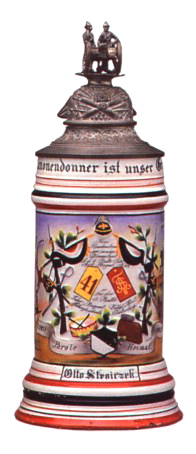|
November Stein of the Month: |
Last Month | Archives | Home
 ~A
Field Artillery Regimental Stein~
~A
Field Artillery Regimental Stein~
Definition of a Regimental
Beer Stein
To be considered a regimental beer stein by collectors, a stein must meet
certain minimum criteria. It must have a handle, lid and thumblift, have been
produced during the Second German Empire with an appreciable military motif, and
must incorporate the name of the original owner, his unit designation and
garrison town, along with the years he served in the military. Regimental beer
steins were made of porcelain, pottery, stoneware, glass or pewter, and most
often, in a rather traditional turn of the century beer stein configuration.
Origin of Regimental Beer Steins
During the twenty-five years (1890-1914) before the outbreak of World War I,
many young men in the German and Bavarian Armies purchased a souvenir as a
positive and tangible remembrance of their two or three years of active military
training. These souvenirs were diverse, and included walking sticks, pipes,
schnapps flasks, group photographs and beer steins. Beer steins were the most
high-priced souvenirs, costing four to seven weeks pay in those days, depending
on how they were decorated. Only those recruits (about 10%) who regularly saved
something out of their insufficient earnings could afford these colorful
mementos of military service. Their regimental steins were ordered in the spring
to allow sufficient time for manufacturing and the usual amount of
personalization. Recruits who anticipated passing into the reserve gathered
together to select the style and decoration of their remembrance steins. After
reaching their decisions, the men placed a group order, with a modest down
payment, to get the lowest price possible. Their steins were delivered in late
September, just before they left the service and returned to their families and
civilian life.
How Many Regimental Beer Steins?
No one has an accurate figure for how many regimental beer steins survive to
this day, but we can make broad assumptions and informed estimates. We do know
that an average of 225,000 recruits joined the German and Bavarian Armies
annually, between 1890 and 1914, the period when regimental beer steins were
produced. We also know that only about 10% of the recruits purchased a
regimental stein. Further, large quantities of steins were destroyed during the
scrap metal drives during the two world wars, as well as in the bombing raids in
the second war. Finally, we know that families destroyed regimental steins in
fear of what the advancing allied forces might surmise upon seeing a cherished
military artifact in their homes. From all of this it is reasonable to assume
that 95% of the total number of regimental steins produced have been destroyed.
This leads to an estimate that roughly 28,000 regimental steins survived. Of
those, we can assume about one half continue undiscovered, with the other half
in collections in the United States and Germany.
Collecting Regimental Beer Steins
Interest in collecting regimental beer steins began in the late 1940's and the
1950's, when American GIs came home from Germany with steins they had purchased
for a few dollars or bartered for a Hershey bar. The German people were
destitute at that time, and willing to sell almost anything, even grandfather's
beer stein, for bread or some coal to warm themselves during several record cold
winters. Over the next twenty or thirty years, regimental stein collecting was
rather haphazard, as few collectors had any understanding of the significance of
these turn of the century collectibles. That changed in 1979, when the first
basic text on regimental beer steins was published. The creation and growth of
Stein Collectors International (SCI) over the last thirty years, has also
prompted an understanding of and an interest in regimental beer steins,
primarily through its quarterly publication, Prosit, and by scholarly
presentations at annual SCI conventions. In 1997, the second book on regimental
beer steins was published, taking this hobby to even greater levels of interest,
especially among the Germans who regularly show up at stein auctions in this
country.
In past years it was occasionally possible to find an antique regimental beer
stein in shops in the United States or Germany. Generally speaking, that is no
longer the case. Regimental beer steins found in antique shops today are almost
always contemporary reproductions. This statement should be taken seriously by
anyone who may in the future "discover" an attractive regimental stein
in an antique shop somewhere! The reality is, presently, most authentic
regimental beer steins change hands at international stein conventions, periodic
beer stein auctions, or in private exchanges between collectors.
R. Ron Heiligenstein, SCI Master Steinologist
Author, Regimental
Beer Steins, 1890-1914
© Stein Collectors International 1996 -99